The women’s game in Mexico has experienced quite a bit of growth in the last four years, with the start of the Liga MX Femenil in July 2017. The beginning of this league in Mexico has helped develop talent that has improved the national team, especially at the youth level, to turn around years of neglect. Before starting the league, Mexico had only reached three FIFA Women’s World Cup finals since 1991. The youth squads have also struggled in international competitions, never making it out of the quarter-finals in any U-17 and U-20 Women’s World Cup.
The development of youth players through the Liga MX Femenil has changed the women’s game outlook in Mexico. It started in 2018 when Mexico won the CONCACAF Women’s U-17 Championship. Later in 2018, they would also finish runner-up in the FIFA U-17 Women’s World Cup. Mexico followed this up by finishing second at the 2020 CONCACAF Women’s U-20 Championship. The youth team’s improvements look set to transition to their senior side over the next couple of seasons.
Player Profile
One of the key players in the U-17 and U-20 side has been Alison Gonzalez, a 19-year-old striker currently playing at Atlas. Despite not even being 20 years old, she is already being talked about in women’s football as a star of the future. She’s ranked #3 in the 2021 women’s NXGN list, but her trajectory seems to be only up after her past 12 months.
She made her debut with Tigres UNAL at age 15, helping her side win the 2018 Clausura. Over the next two years, she would score 11 goals throughout 22 matches for the Monterrey-based side. She would also score four goals with the Mexican U-17 side and claim the Golden Boot at the 2018 CONCACAF Women’s U-17 Championship. Despite the goals, she only made five starts throughout two seasons for Tigres UNAL and moved to Atlas at the beginning of 2019.
Since she arrived in Guadalajara, she has continued to improve. She’s scored 47 goals in 67 league appearances with Atlas. However, in the last year, she’s scored 32 goals in 33 league appearances. With her proven goalscoring record, she’s earned the nickname of Aligol in Mexican football.
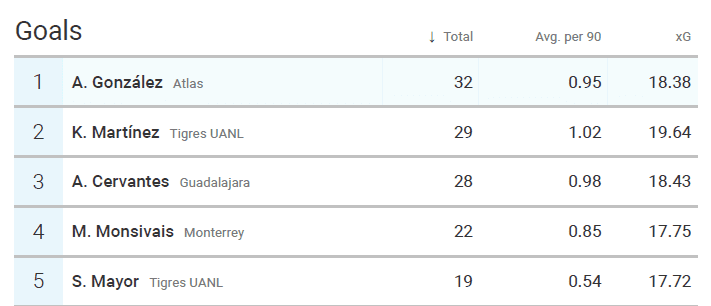
Aligol is known for her clinical finishing, but she’s more than just a poacher. She has proven herself to be versatile, able to play multiple roles across the front line. She’s able to play with her back to goal, but she truly excels when she’s able to make runs to break the defensive line. She has blistering pace, and her spatial awareness makes her very dangerous, both in possession and without.
She has started to improve her link-up skills, which need improvement after only three assists in the past 12 months. Even with some struggles in her link-up play, her willing runs and constant movement often create space for teammates. She is also aggressive without the ball, allowing her team to press effectively from the front.
Attacking Movement & Transitions
Aligol is a very effective mobile forward who can utilise her pace to manipulate the space around her. As we can see from the graphic below, she has been used across Atlas’s front line. Her most effective position is as a lone striker, and she’s able to drop off the centre-backs and operate in the space between the lines.
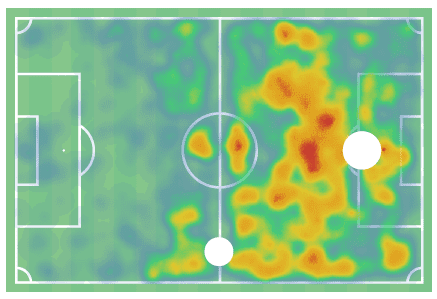
Her effectiveness between the lines owes much to her pace and her willingness to run in behind the defence. Her runs have made centre-backs hesitant to step out of position with her, to mark her tight, as she’s shown repeatedly her ability to turn the defender and get behind them.
In the second graphic, we see how Aligol uses her pace to attack the channels. Atlas’ typical attacking method is to play a through ball into the channel outside the centre-backs and allow Gonzalez to use her pace to get onto the end of it. This play eventually ends up in a sliding challenge by the goalkeeper to prevent the Atlas forward from being able to collect the ball. Without the goalkeeper’s quick play, Gonzalez would have been an excellent chance as she could easily outpace the defender.
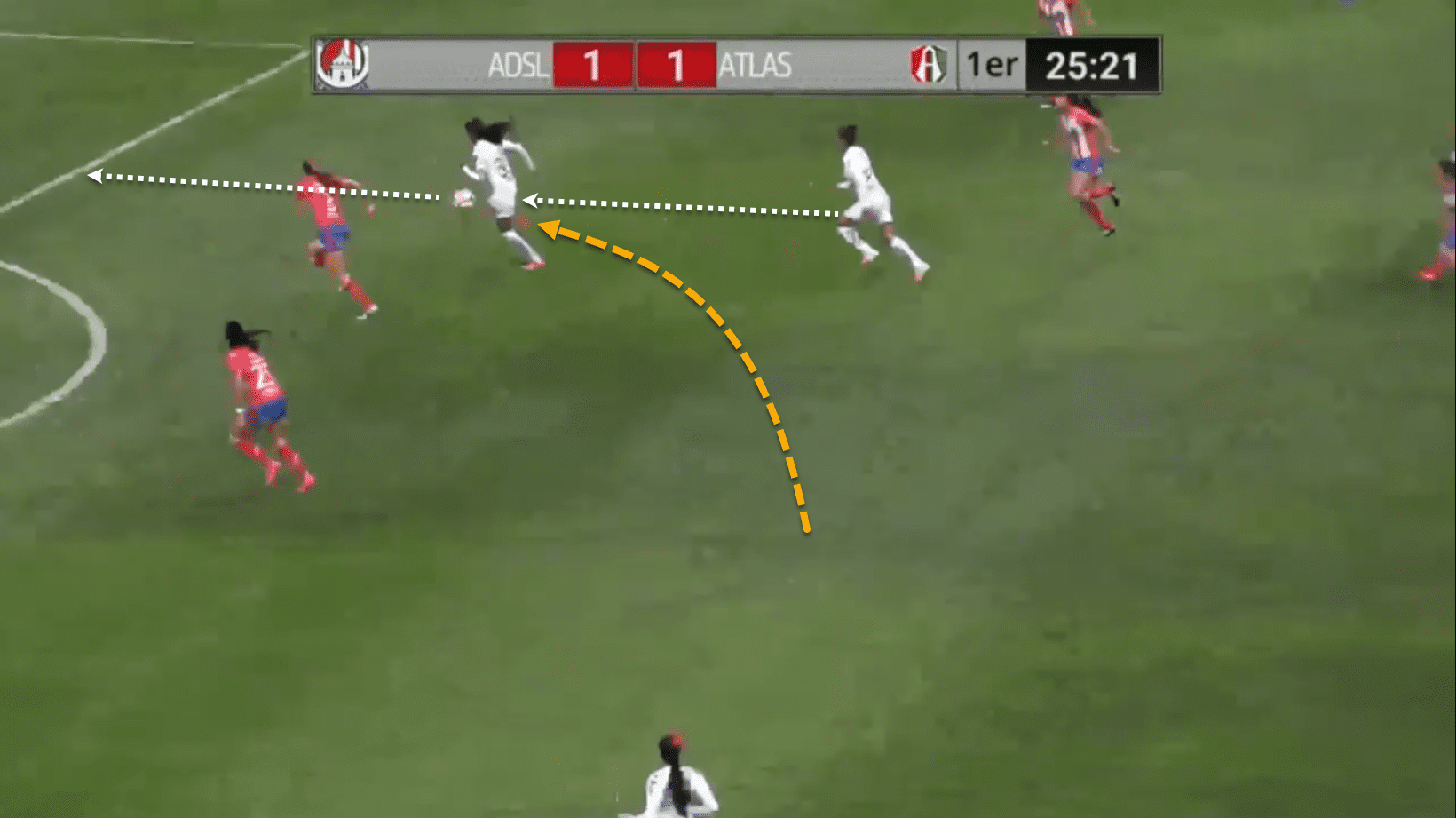
Her movement also opens up space in the midfield. She can occupy both of the opposing centre-backs by herself, and with her runs and movement in behind the defensive line, she often can force them back. We can see in the following image that Aligol continues her forward run, pushing the centre-backs to drop deeper to mark her. This movement creates space for the midfielder to operate with the ball.
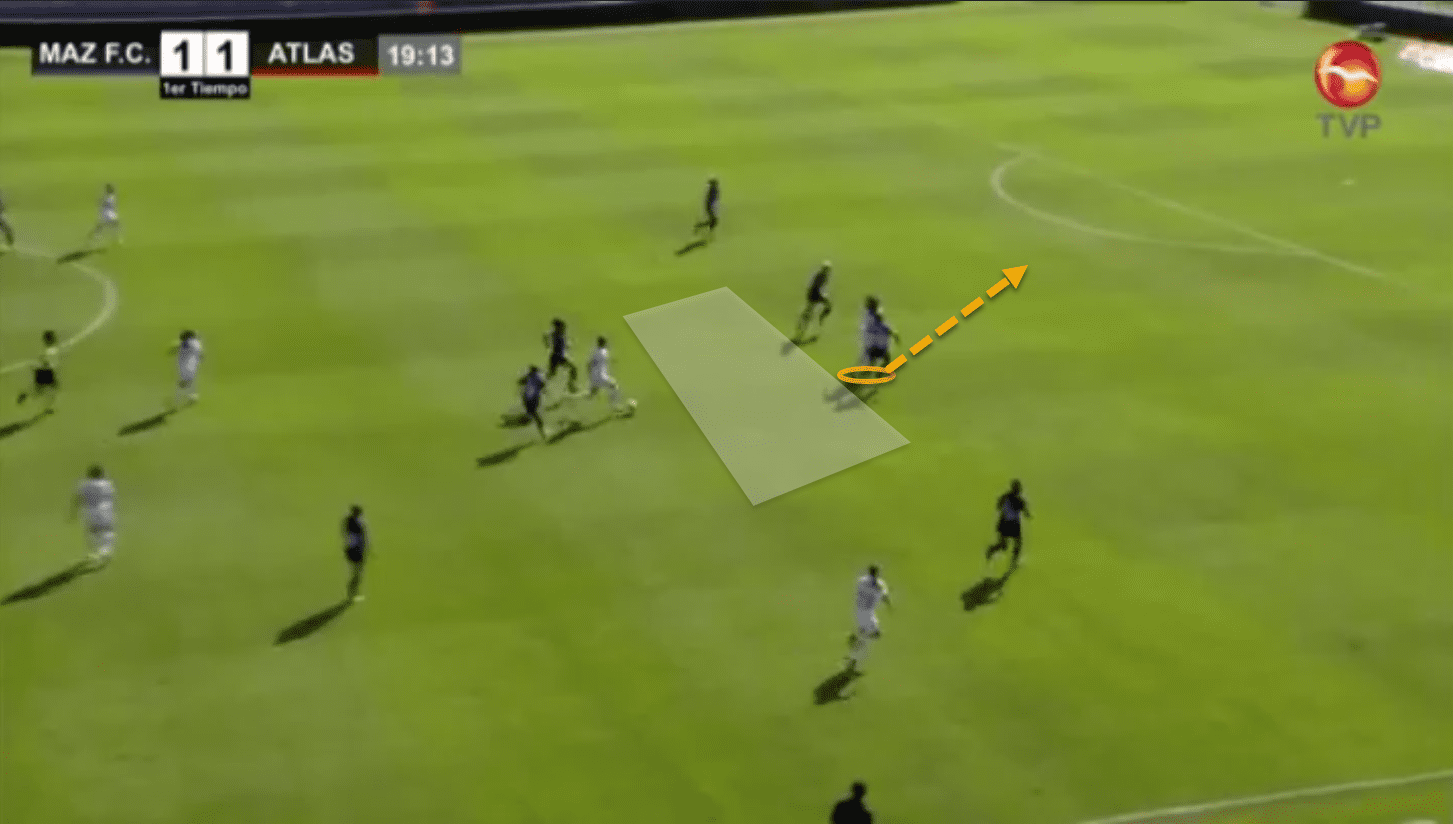
Aligol has rated in the top 20 in Liga MX Femenil over the past year in progressive runs and offensive duels. These stats show that she has become a dangerous option to lead the line, as her relentless runs have created opportunities for herself and her teammates. Her quality runs behind the defensive line also makes it hard for the opposition to maintain a high line and press Atlas in their half. It’s an easy skill to overlook, but her willing runs and skill in winning offensive duels allow more time on the ball for her teammates in deeper positions.
These traits are an essential consideration for Mónica Vergara as the national team coach. Her current choice to lead the line for Mexico is Katty Abad, who played alongside Alison Gonzalez when they were both at Tigres UNAL. Katty Abad was a more natural goalscorer at the time, but with Aligol’s improvements, that isn’t true any longer. Aligol has proven herself to be a dangerous striker, but her pace and runs make her a better option for a side looking to become better in possession.
Dribbling and Strength
Aligol is 5 foot 7 inches tall and 110 pounds, but her strength is a positive. She can play with her back to the goal, as she still has the power to hold off defenders. She has exceptional dribbling skills and the strength to stay on her feet when challenged. In the image below, Aligol receives the ball just inside her half. She can turn upfield and attack the retreating defenders at pace. With little support from her side, four Atletico San Luis defenders close on her.
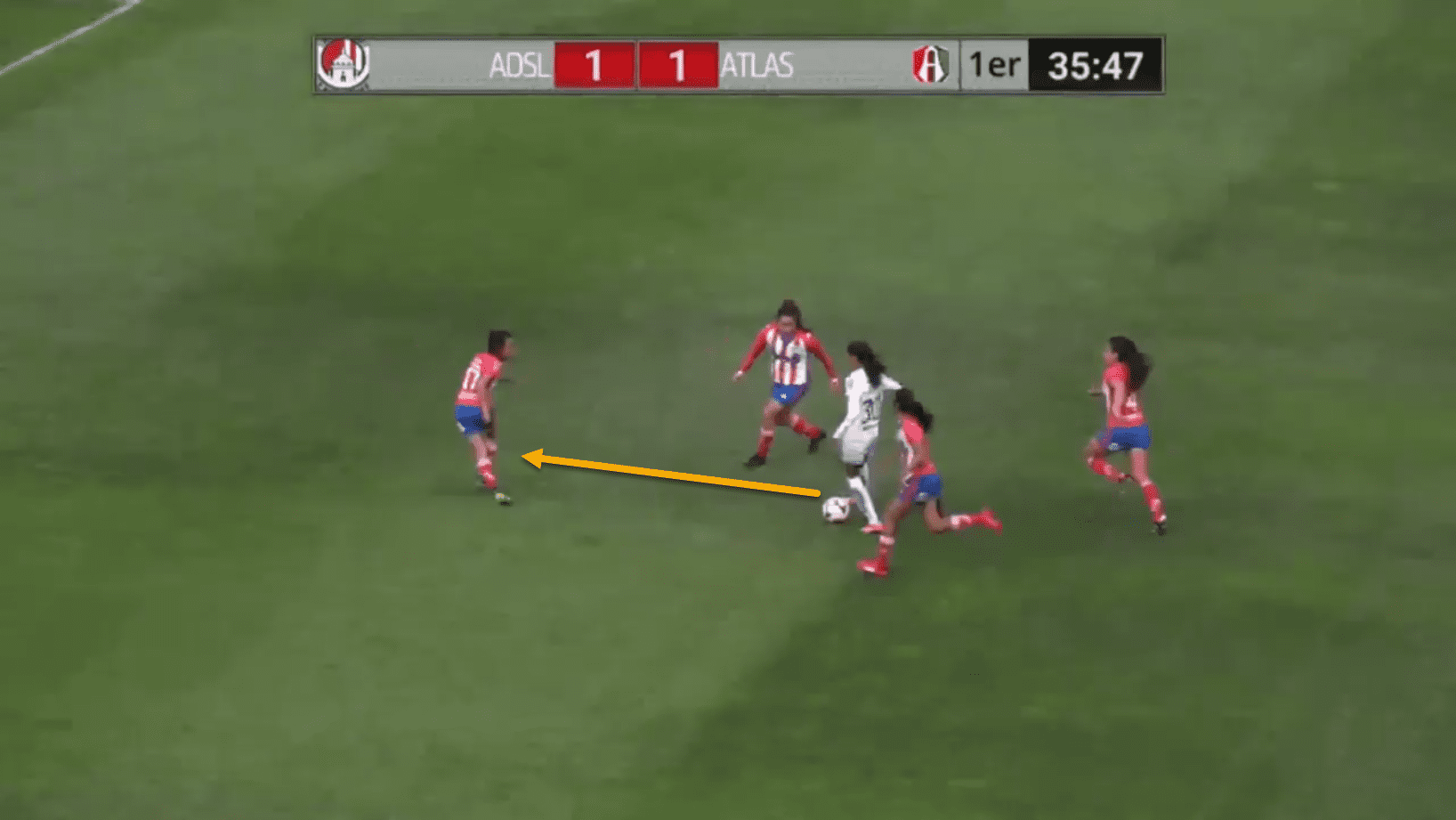
In the following image, Alison Gonzalez uses her pace to bypass two of the defenders. She dribbles between the two centre-backs and is strong enough to fight through the challenge. In the final image below, we see that Aligol has got past all four defenders and can curl a shot in the far post to give Atlas the lead.
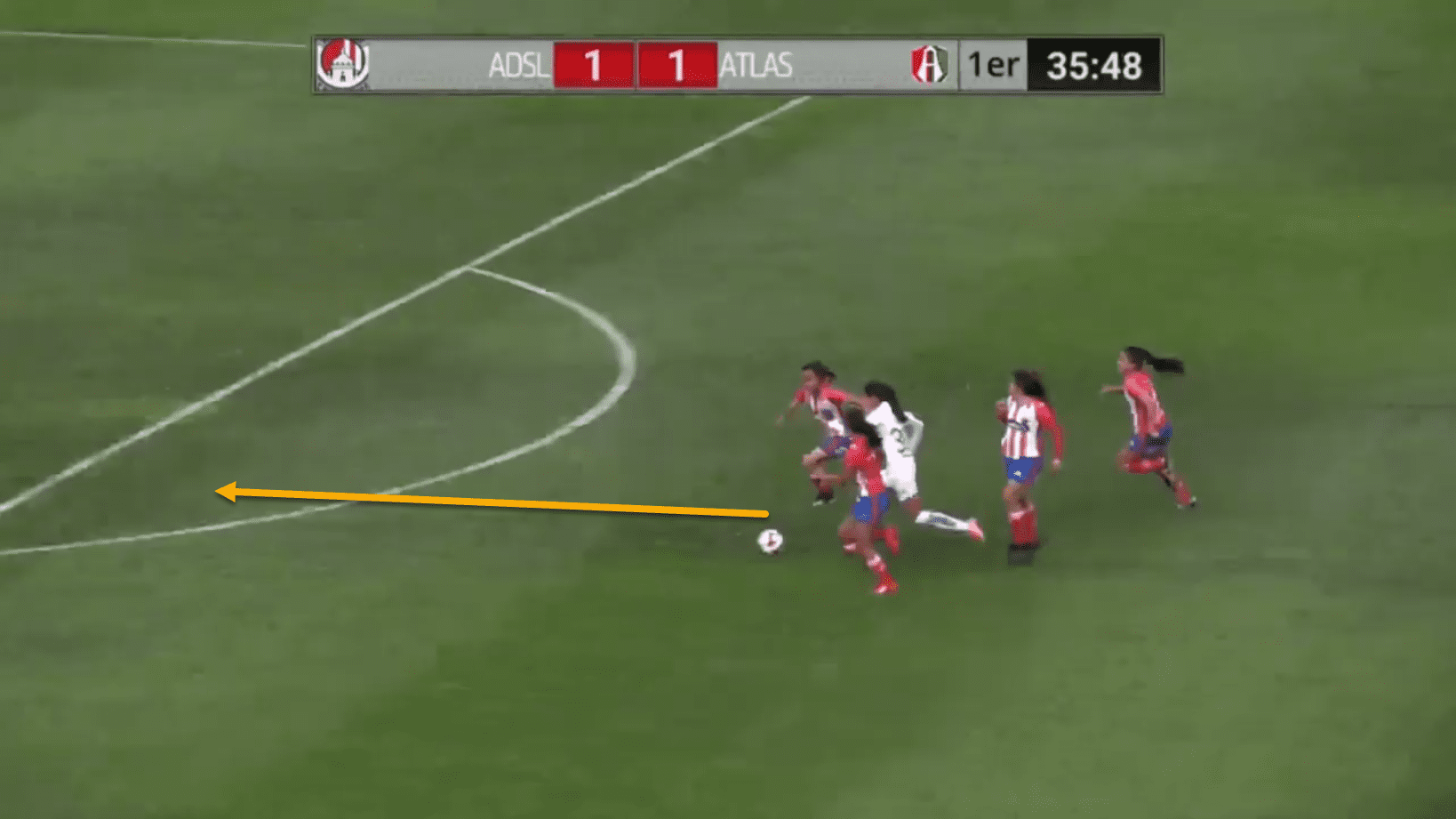
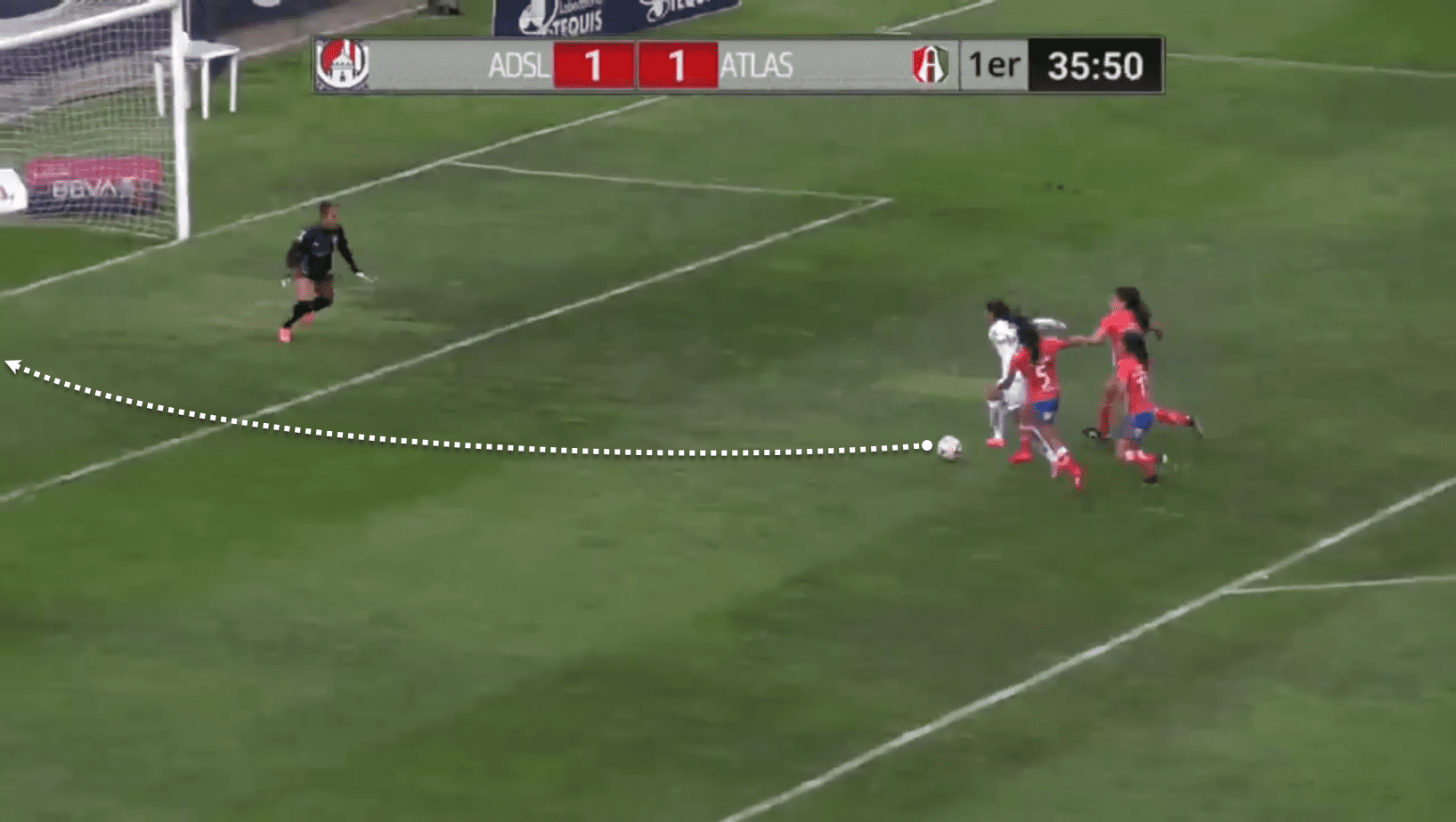
The 19-year-old also reads the game well and frequently finds herself in quality positions. Atlas aren’t afraid to play the ball long and allow Aligol to use her pace and strength to carve out opportunities. She has had success getting on the end of flick-ons and second balls.
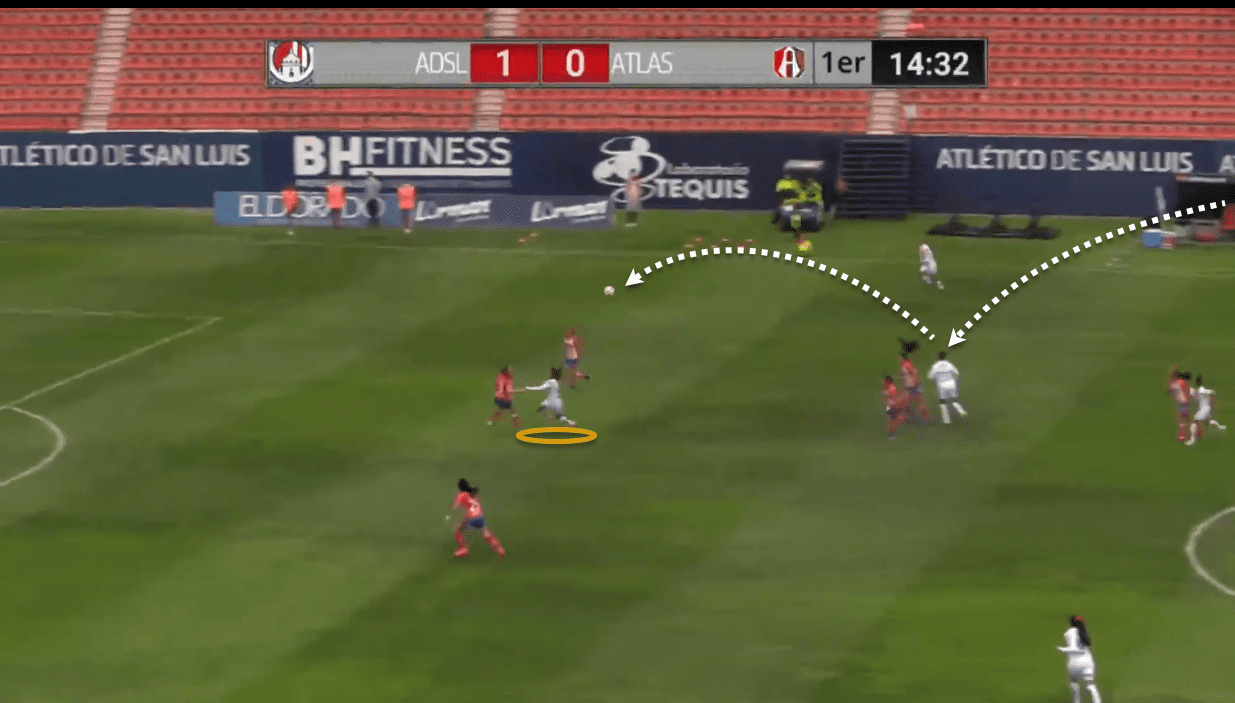
The image above shows the goalkeeper playing a long ball into the opposing half. Zellyka Arce wins the header and flicks it on for Aligol. Gonzalez reads the play well and starts her run before the centre-backs have a chance to react to the ball. In the image below, the Atlas striker can single out one of the opposing centre-backs and use her strength and turn of pace to beat her to the flick-on.
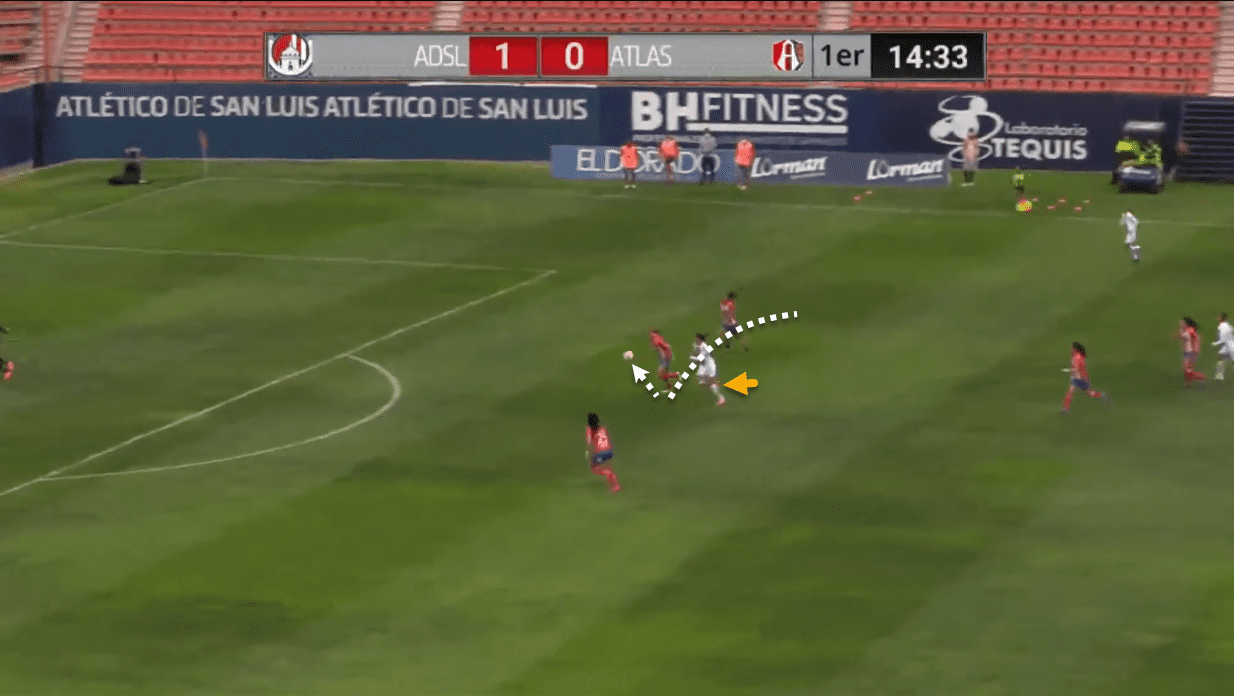
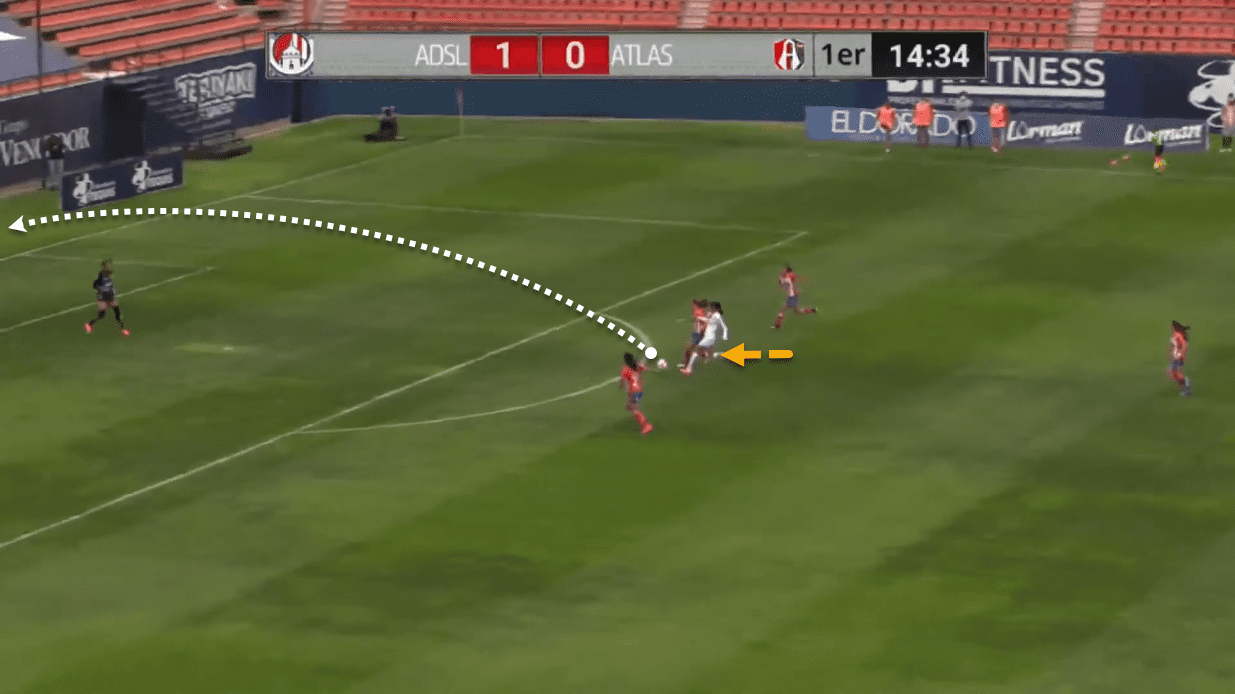
In the image above, Alison Gonzalez beats the centre-back to the ball. She has the intelligence and vision to see the goalkeeper out of position. She then has the skill to chip the ball over the goalkeeper to score the match’s opening goal.
This goal shows many positives of Alison Gonzalez’s game as she has matured. Her ability to read the game and move into position to get on the end of the knock-on. She also uses her pace to close the space with the centre-back and beat her to the ball. Finally, she uses her vision and deft touch to chip the ball from 20 yards over the goalkeeper, who has been caught in no man’s land to score an excellent goal. A lesser forward may have failed at any of these points, but this 19-year-old striker could succeed at all of them to score an excellent goal.
Improvements
Over the past year, Alison Gonzalez has improved several parts of her game. Her finishing has become better, with her averaging almost a goal per game last season in Liga MX Femenil. Aligol has also improved her work rate, allowing her to become a much better defender. Her ability to force recoveries in the opposition’s final third has added a dangerous weapon to her side. In previous season’s, Atlas was forced to play a more passive system. If they wanted to press higher up the pitch, it was common to see Aligol forced to play in a wide position to cover for her poor work rate.
Gonzalez’s work rate improved considerably this season, and as a result, she has been primarily starting as the lone striker for her side. The result of her work rate is evident in the graphic below, showing her recoveries high up the pitch.
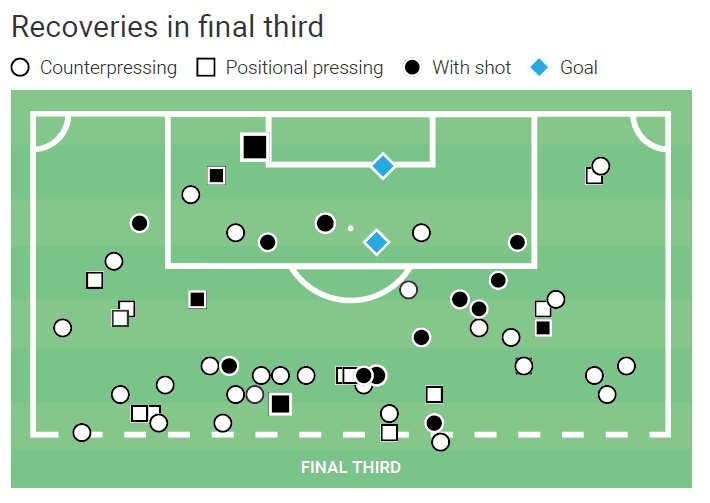
Her willingness to press high up the pitch has resulted in two of her goals and creating numerous chances for her side.
Alison Gonzalez doesn’t just use her pace and aggressiveness on the attack. She also shows the same work rate out of possession. Gonzalez helps her side press the opposition high up the pitch. Instead of just pressing the centre-back, as most forwards would be content to do, she is also committed to applying a back press and putting the opposition’s midfield under pressure from behind.
The following images show the dedication that Gonzalez applies out of possession, as she applies pressure from behind on the Atletico San Luis midfield. She chases down the midfielder from behind and reads the next pass, moving to block the passing lane. With her reading of the play, she can intercept the pass and immediately start a counter-attack.
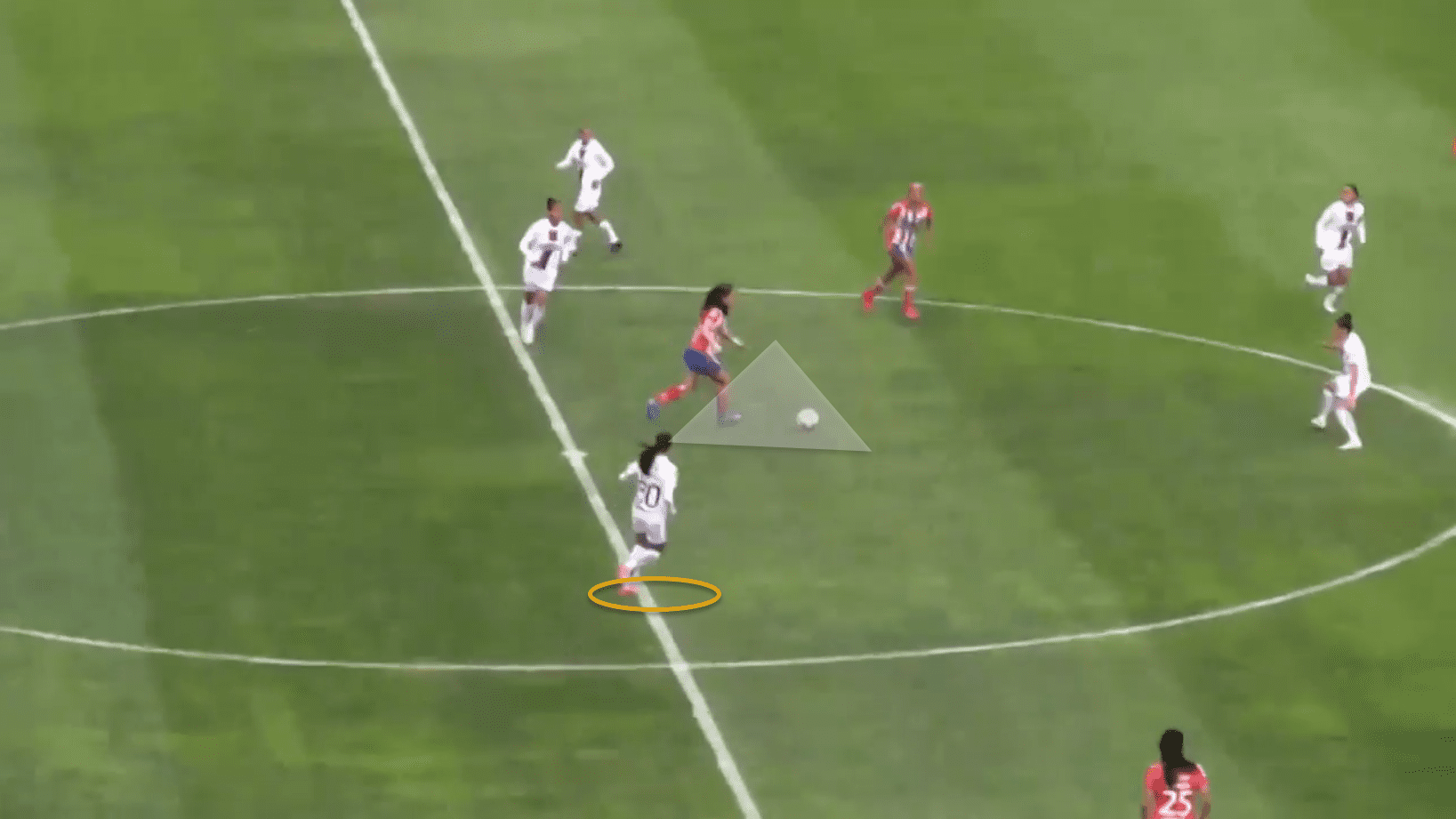
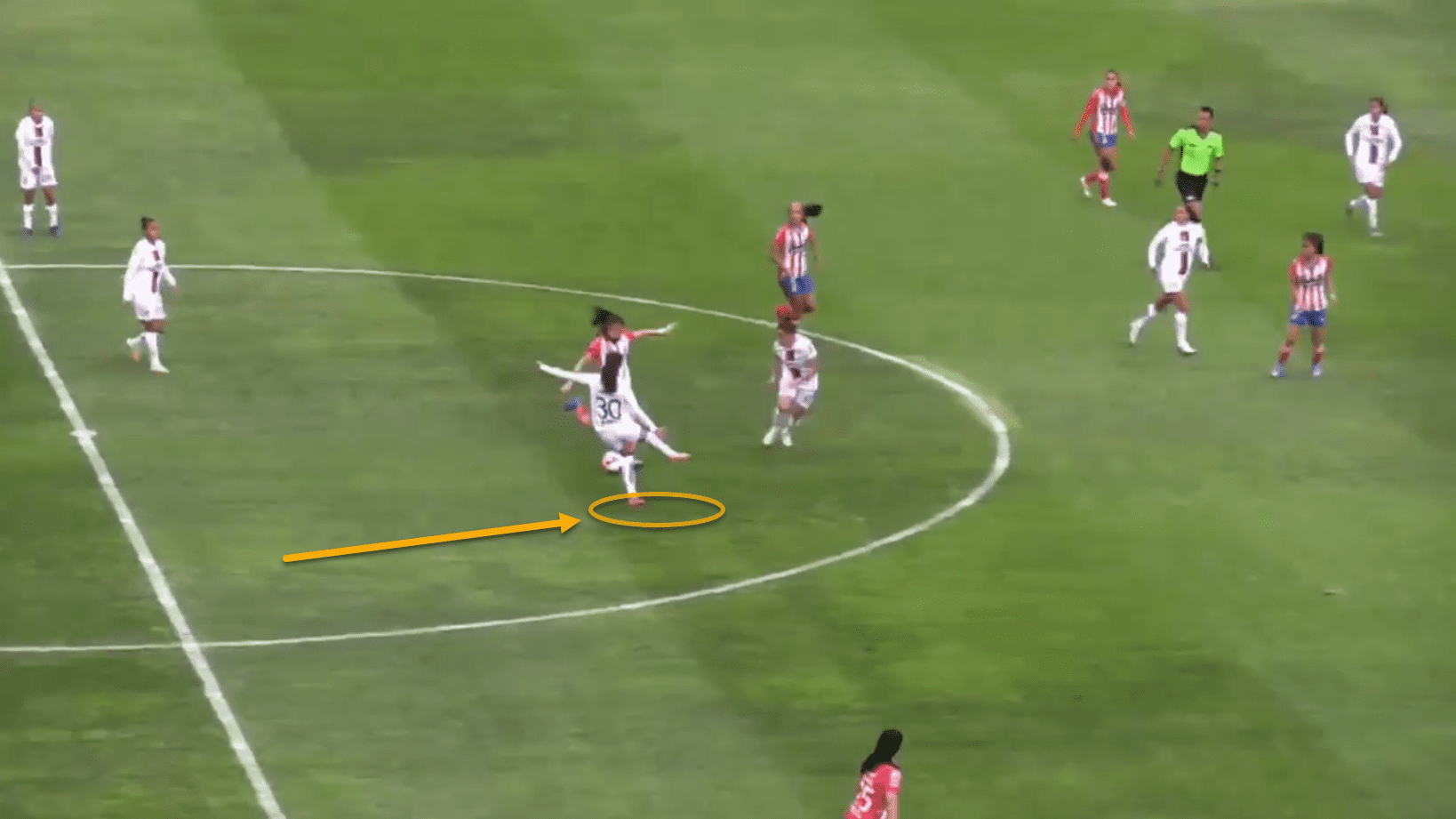
Her effectiveness in this role has allowed Atlas to be one of the best pressing teams in Mexico. Last season in Liga MX Femenil, Aligol ranked in the top 10 in both recoveries in the final third and counter-pressing recoveries. This pressing style is something that Mexico head coach Mónica Vergara has been trying to create with the national side, but she hasn’t been able to get the side to press cohesively. The current starting striker for the national side Katty Abad is a practical goal scorer. Still, she struggles to play the energetic pressing role that Alison Gonzalez is capable of providing.
Conclusion
Alison Gonzalez is one of the best young strikers globally and has shown large scale improvement over the past 12 months. She has become much more clinical in front of goal and has improved her work rate without the ball. She now has the skills and abilities to play as a lone striker for both club and country. Her pace makes her a dangerous option that will allow the Mexico Women’s National Team to play a more aggressive pressing style. She will also make the side more dangerous on the counter-attack. This is a side that is trying to transition to a more possession-based system under Mónica Vergara, which makes Aligol a more attractive option as the lone striker over Katty Abad.
While there remains a large gap between the USA and Mexico as the top sides in CONCACAF, the talent in the young Liga MX Femenil means that the gap should tighten over the next few years as players like Aligol become regular starters with the senior side.





Comments